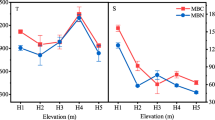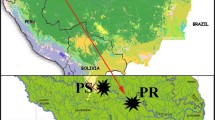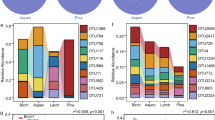Abstract
The objective of the present study was to evaluate the combined effect of vegetation and N deposition on microbial community composition in forest soils. For this, microbial biomass and community structure were assessed by ester linked fatty acid methyl ester (EL-FAME) analyses for 12 European forest sites representing different forest types (coniferous/deciduous) and differing in annual N loads (2–40 kg N ha−1). Microbial community composition was affected by vegetation as indicated by a higher proportion of the marker for arbuscular mycorrhiza (AM) fungi—16:1 11ω—in deciduous forest soils (1.2%–5.7% of total EL-FAMEs) compared to acidic coniferous forest soils (0.5%–1.6%). The two pine forest sites investigated showed the highest proportion of fungi (up to 28% of total EL-FAMEs) and the lowest proportions of Gram-negative and Gram-positive bacteria of all study sites. Nitrogen deposition rates were highly correlated with the ratios of cyclopropyl fatty acids to their precursors (r = 0.82; P < 0.01) and of bacteria to fungi (r = 0.71; P < 0.05). The two sites with the highest N deposition (≥32.3 kg N ha−1a−1) were depleted in the marker fatty acids for AM fungi and other fungi. Our findings suggest that vegetation has a pronounced effect on microbial community structure, but this effect is masked by high N inputs (>30 kg N ha−1a−1).




Similar content being viewed by others
References
Amato M, Ladd JN (1988) Assay for microbial biomass based on ninhydrin-reactive nitrogen in extracts of fumigated soils. Soil Biol Biochem 20:107–114
Ambus P, Zechmeister-Boltenstern S, Butterbach-Bahl K (2006) Sources of nitrous oxide emitted from European forest soils. Biogeoscience 3:135–145
Andersen AJ, Petersen SO (2009) Effects of C and N availability and soil-water potential interactions on N2O evolution and PLFA composition. Soil Biol Biochem 41:1726–1733
Andrews JH, Hall RF (1986) R- and K-selection and microbial ecology. Adv Microb Ecol 9:99–147
Beney LP, Gervais P (2001) Influence of the fluidity of the membrane on the response of microorganisms to environmental stresses. Appl Microbiol Biot 57:34–42
Bossio DA, Scow KM, Gunapala N, Graham KJ (1998) Determinants of soil microbial communities: effects of agricultural management, season, and soil type on phospholipid fatty acid profiles. Microbial Ecol 36:1–12
Carreiro MM, Sinsabaugh RL, Repert DA, Parkhurst DF (2000) Microbial enzyme shifts explain litter decay responses to simulated nitrogen deposition. Ecology 81:2359–2365
Cavigelli MA, Robertson GP, Klug MJ (1995) Fatty acid methyl ester (FAME) profiles as measures of soil microbial community structure. Plant Soil 170:99–113
Compton JE, Watrud LS, Arlene Porteous L, DeGrood S (2004) Response of soil microbial biomass and community composition to chronic nitrogen additions at Harvard forest. Forest Ecol Manag 196:143–158
DeForest JL, Zak DR, Pregitzer KS, Burton AJ (2004) Atmospheric nitrate deposition and the microbial degradation of cellobiose and vanillin in northern hardwood forest. Soil Biochem 36:965–971
Demoling F, Ola Nilsson L, Bσσth E (2008) Bacterial and fungal response to nitrogen fertilization in three coniferous forest soils. Soil Biol Biochem 40:370–379
Dix NJ, Webster J (1995) Fungal ecology. Chapman and Hall, London
Fay L, Richli U (1991) Location of double bonds in polyunsaturated fatty acids by gas chromatography-mass spectrometry after 4, 4-dimethyloxazoline derivatization. J Chromatogr 451:89–98
Federle TW (1986) Microbial distribution in soil—new techniques. In: Megusar F, Gantar M (eds) Perspectives in microbial ecology. Slovene Society for Microbiology, Ljubljana, pp 493–498
Finlay RD, Söderström B (1989) Mycorrhizal mycelia and their role in soil and plant communities. In Clarholm M, Bergström L (eds) Ecology of arable land—perspectives and challenges. Dev Plant Soil Sci 39:139–148
Frey SD, Knorr M, Parrent JL, Simpson RT (2004) Chronic nitrogen enrichment affects the structure and function of the soil microbial community in temperate hardwood and pine forests. Forest Ecol Manag 196:159–171
Frostegård A, Bååth E (1996) The use of phospholipid fatty acid analysis to estimate bacterial and fungal biomass in soil. Biol Fertil Soils 22:59–65
Frostegård Å, Bååth E, Tunlid A (1993) Shifts in the structure of soil microbial communities in limed forests as revealed by phospholipid fatty acid analysis. Soil Biol Biochem 25:723–730
Gallo M, Amonette R, Lauber C, Sinsabaugh RL, Zak DR (2004) Microbial community structure and oxidative enzyme activity in nitrogen-amended north temperate forest soils. Microbial Ecol 48:218–229
Grayston SJ, Campbell CD, Bardgett RD, Mawdsley JL, Clegg CD, Ritz K, Griffiths BS, Rodwell JS, Edwards SJ, Davies WJ, Elston DJ, Millard P (2004) Assessing shifts in microbial community structure across a range of grasslands of differing management intensity using CLPP, PLFA and community DNA techniques. Appl Soil Ecol 25:63–84
Grogan DW, Cronan JE (1997) Cyclopropane ring formation in membrane lipids of bacteria. Microbiol Mol Biol Rev 61:429–441
Guckert JB, Hood MA, White DC (1986) Phospholipid ester-linked fatty acid profile changes during nutrient deprivation of Vibrio cholerae: increases in cis/trans ratio and proportions of cyclopropyl fatty acid. Appl Environ Microbiol 52:794–801
Hackl E, Pfeffer M, Donat C, Bachmann G, Zechmeister-Boltenstern S (2005) Composition of the microbial communities in the mineral soil under different types of natural forest. Soil Biol Biochem 37:661–671
Han XM, Wang RQ, Liu R, Wang MC, Zhou J, Guo WH (2007) Effects of vegetation type on soil microbial community structure and catabolic diversity assessed by polyphasic methods in North China. J Environ Sci 19:1228–1234
Hannam KD, Quideau SA, Kishchuk BE (2006) Forest floor microbial communities in relation to stand composition and timber harvesting in northern Alberta. Soil Biol Biochem 38:2565–2575
Härtel E, Zechmeister-Boltenstern S, Gerzabek M (2002) Gaseous nitrogen losses from a forest Site in the North Tyrolean Limestone Alps. Environ Sci Poll Res, Special Issue 2:23–30
Harwood JL, Russell NJ (1984) Lipids in plants and microbes. G. Allen, London
Islam MR, Trivedi P, Palaniappan P, Reddy MS, Sa T (2009) Evaluating the effect of fertilizer application on soil microbial community structure in rice based cropping system using fatty acid methyl esters (FAME) analysis. World J Microbiol Biotechnol 25:1115–1117
Killham K (1994) Soil ecology. Cambridge University Press, Cambridge, UK
Kitzler B, Zechmeister-Boltenstern S, Holtermann C, Skiba U, Butterbach-Bahl K (2006) Controls over N2O, NOx and CO2 fluxes in a calcareous mountain forest soil. Biogeosciences 3:293–310
Kroppenstedt RM (1985) Fatty acids and menaquinone analysis of actinomycetes and related organisms. In: Goodfellow M, Minnikin DE (eds) Chemical methods in bacterial systematics. Academic, London, pp 173–199
Landgraf D, Wedig D, Klose S (2005) Medium- and short-term available organic matter, microbial biomass, and enzyme activities in soils under Pinus sylvestris L. and Robinia pseudoacacia L. in a sandy soil in NE Saxony, Germany. J Plant Nutr Soil Sci 168:193–201
Larsen J, Olsson PA, Jakobsen J (1998) The use of fatty acid signatures to study mycelia interactions between the arbuscular mycorrhizial fungus Glomus intradices and the saprophytic fungus Fusarium culmorum in root–free soil. Mycol Res 102:1491–1496
Nilsson LO, Bååth E, Falkengren-Grerup U, Wallander H (2007) Growth of ectomycorrhizal mycelia and composition of soil microbial communities in oak forest soils along a nitrogen deposition gradient. Oecologia 153:375–384
Olsson PA (1999) Signature fatty acids provide tools for determination of the distribution and interactions of mycorrhizal fungi in soil. FEMS Microbial Ecol 29:303–310
Pennanen T (2001) Microbial communities in boreal coniferous forest humus exposed to heavy metals and changes in soil pH—a summary of the use of phospholipids fatty acids, Biolog® and 3H—Thymidine incorporation methods in field studies. Geoderma 100:91–126
Petersen SO, Roslev P, Bol R (2004) Dynamics of a pasture soil microbial community after deposition of cattle urine amended with [C-13]urea. Appl Environ Microbiol 70:6363–6369
Pilegaard K, Skiba U, Ambus P, Beier C, Brüggemann N, Butterbach-Bahl K, Dick J, Dorsey J, Duyzer J, Gallagher M, Gasche R, Horvath L, Kitzler B, Leip A, Pihlatie MK, Rosenkranz P, Seufert G, Vesala T, Westrate H, Zechmeister-Boltenstern S (2006) Factors controlling regional differences in forest soil emission of nitrogen oxides (NO and N2O). Biogeoscience 3:651–661
Priha O, Grayston SJ, Hiukka R, Pennanen T, Smolander A (2001) Microbial community structure and characteristics of the organic matter in soils under Pinus sylvestris, Picea abies and Betula pendula at two forest sites. Biol Fertil Soils 33:17–24
Rajendran N, Matsuda O, Urushigawa Y, Simidu U (1994) Characterization of microbial community structure in the surface sediment of Osaka Bay, Japan, by phospholipid fatty acid analysis. Appl Environ Microbiol 60:248–257
Ritchie NJ, Schutter ME, Dick RP, Myrold DD (2000) Use of length heterogeneity PCR and fatty acid methyl ester profiles to characterize microbial communities in soil. Appl Environ Microbiol 66:1668–1675
Romesburg CH (2004) Cluster analysis for researchers. Lulu Press, North Carolina
Saetre P, Bååth E (2000) Spatial variation and patterns of soil microbial community structure in a mixed spruce-birch stand. Soil Biol Biochem 32:909–917
Saiya-Cork KR, Sinsabaugh RL, Zak DR (2002) The effects of long term nitrogen deposition on extracellular enzyme activity in an Acer saccharum forest soil. Soil Biol Biochem 34:1309–1315
Schutter ME, Dick RP (2000) Comparison of Fatty Acid Methyl Ester (FAME) methods for characterizing microbial communities. Soil Sci Soc Am J 64:1959–1668
Schutter ME, Dick RP (2002) Microbial community profiles and activities among aggregates of winter fallow and cover-cropped soil. Soil Sci Soc Am J 66:142–153
Sinsabaugh RL, Zak DR, Gallo M, Lauber C, Amonette R (2004) Nitrogen deposition and dissolved organic carbon production in northern temperate forests. Soil Biol Biochem 36:1509–1515
Smith SE, Read DJ (1997) Myrorrhizal symbiosis. Academic, San Diego
Spitzer V (1997) Structure analysis of fatty acids by gas chromatography—low resolution electron impact mass spectrometry of their 4, 4-Dimethyloxazoline Derivatives—a Review. Prog Lipid Res 35:387–408
Tang YS, Cape JN, Sutton MA (2001) Development and types of passive samplers for monitoring atmospheric NO2 and NH3 concentrations. Sci World 1:513–529
Tietema A (1998) Microbial carbon and nitrogen dynamics in coniferous forest floor material collected along a European nitrogen deposition gradient. Forest Ecol Manag 101:29–36
Van Gestel M, Merckx R, Vlassak K (1993) Microbial biomass responses to soil drying and rewetting: the fate of fast- and slow-growing microorganisms in soils from different climates. Soil Biol Biochem 25:109–123
Vitousek PM, Aber JD, Howarth RW, Likens GE, Matson PA, Schindler DW, Schlesinger WH, Tilman DG (1997) Human alteration of the global nitrogen cycle: sources and consequences. Ecol Appl 7:737–750
Waldrop MP, Zak DR, Sinsabaugh RL (2004) Microbial community response to nitrogen deposition in northern forest ecosystems. Soil Biol Biochem 36:1443–1451
White DC, Bobbie RJ, Nickels JS, Fazio SD, Davis WM (1980) Nonselective biochemical methods for the determination of fungal mass and community structure in estuarine detrital microflora. Bot Mar 23:239–250
White C, Tardif JC, Adkins A, Staniforth R (2005) Functional diversity of microbial communities in the mixed boreal plain forest of central Canada. Soil Biol Biochem 37:1359–1372
Zechmeister-Boltenstern S, Schindlbacher A, Ambus P, Butterbach-Bahl K (2004) Nitrogen oxides emissions in relation to microbial parameters at 13 European forest sites. Geophys Res Abstr 6:5151
Zechmeister-Boltenstern S, Hackl E, Bachmann G, Pfeffer M, Englisch M (2005) Nutrient turnover, greenhouse gas exchange and biodiversity in natural forests of Central Europe. In: Binkley D, Menyailo (eds) Tree species effects on soils: implications for global change. NATO Science Series 55, Kluwer Academic Publishers, Dordrecht, pp 31–49
Zhong Z, Makeschin F (2005) Differences of soil microbial biomass and nitrogen transformation under two forest types in central Germany. Plant Soil 283:287–297
Acknowledgements
We thank Klaus Butterbach-Bahl for excellent project coordination. We thank Brigitte Schraufstädter and Veronika Bendl for careful laboratory analysis, Barbara Kitzler for field work, and the NOFRETETE team for soil sampling. The work was funded by the European Commission in the NOFRETETE project (EVK2-CT2001-00106) of the fifth framework program and co-funded by the NitroEurope Integrated Project (017841) of the sixth framework program.
Author information
Authors and Affiliations
Corresponding author
Additional information
Responsible Editor: Hans Lambers.
Rights and permissions
About this article
Cite this article
Zechmeister-Boltenstern, S., Michel, K. & Pfeffer, M. Soil microbial community structure in European forests in relation to forest type and atmospheric nitrogen deposition. Plant Soil 343, 37–50 (2011). https://doi.org/10.1007/s11104-010-0528-6
Received:
Accepted:
Published:
Issue Date:
DOI: https://doi.org/10.1007/s11104-010-0528-6




